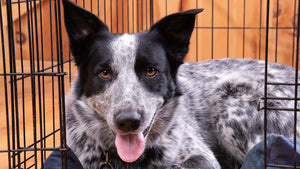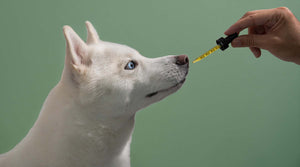Your Cart is Empty
💗FREE shipping on Oprah's Favorite Dog Walking Bag! Everything ships FREE on orders over $30 💗
💗FREE shipping on Oprah's Favorite Dog Walking Bag! Everything ships FREE on orders over $30 💗
💗FREE shipping on Oprah's Favorite Dog Walking Bag! Everything ships FREE on orders over $30 💗
💗FREE shipping on Oprah's Favorite Dog Walking Bag! Everything ships FREE on orders over $30 💗
Add description, images, menus and links to your mega menu
A column with no settings can be used as a spacer
Link to your collections, sales and even external links
Add up to five columns
Add description, images, menus and links to your mega menu
A column with no settings can be used as a spacer
Link to your collections, sales and even external links
Add up to five columns
September 16, 2022 11 min read
Your dog may not know how to tweet or FaceTime, but they sure know how to communicate (even if it’s sometimes hard for you to understand them). Understanding your dog’s body language improves communication between you and your pup, increasing your loyalty points as a paw-rent. We’ll discuss everything from dog tail meaning to smiles and panting.
Being intentional about bonding with our dogs daily makes us feel closer to them. By improving communication with your pup, you’ll know more about their thoughts, what they need, and how they feel.
For example, a position with the head bowed and paw up can mean “hi”' or “I pawmise not to do it again.” Tail wagging, bright eyes, and tongue panting could say, "I'm so glad you are back!" Eyes bulging, mouth open (but no tongue) could mean “OMG!”
Every dog is different, and each dog has so many unique expressions and mannerisms. Getting to know your pup’s unique tells can be a fun way to bond and learn more about them.
We see visual cues from our pups every day, and it is easy to assume that all dogs are straightforward when communicating what they want. But oh, how wrong that is!
All dogs are NOT created identically. It is common to misunderstand canine body language, especially when interacting with new dogs! So many assume that all dogs communicate the same way, which is untrue.
Canine body language can mean different things depending on the context (and the dog!) But when we learn more about the individual pup and judge the situation correctly, we can start to unlock the complex world of canine communication!
It is also important to note that dogs communicate both consciously and subconsciously. There are internal and external factors we need to take into account when understanding dog body language.
Commonly misinterpreted canine body language includes:
Read on to learn more about the different signs of emotions in dogs.
Signs of joy
A joyful dog is a relaxed dog. Dogs express their happiness through their tails and faces. If a dog is happy, their face will likely be relaxed, their ears upright, their eyes bright, their mouth slightly opened, and their tongue exposed. A dog with this demeanor may be ready for a good pet from you.
We all picture a wagging tail when we think of a happy dog! Indeed, tail-wagging is a sign of happiness and excitement in dogs, but a happy pup may also have their tail lowered and relaxed. Some dogs may wag their tails broadly and have a smile on their face. This is often a way of saying “I’m happy” or “Hey, come over and give me a pat!” Dogs that are properly socialized often behave this way.
Did you also know that growling can also be a sign of happiness, especially if it’s during play? As strange as it sounds, a puppy growling while playing is often only excited. Growling is a sign of competitiveness, especially if the pup is playing tug-of-war or wrestling. But if a dog growls and is not playing, approach them with caution and assume it may be a request from the dog not to come closer and retreat from their space if possible.
Pup tip: Though smiling is often a sign of happiness in dogs, always be careful about a smiling dog with a body posture that shows discomfort. If their mouth is open, but the tongue is not exposed, and the lips are pulled back to reveal the teeth, this indicates an aggressive stance. Look for a relaxed mouth with ears pointing forward, too.
Don’t forget to pay attention to body posture. A stiff body with a tail raised halfway is a sign of alertness, and that pup might be ready to charge if pressed uncomfortably. It’s not a good idea to provoke a dog like this, no matter how cute they may be!
Signs of relaxation
If your dog is on their back with their paws up and eyes closed, they might be ready to enjoy a belly rub! Guess what? This means your dog is relaxed and feeling trusting. As long as they don’t seem too submissive or scared, a dog exposing their belly is a sign of deep trust. Maybe your dog waits for you to settle down on the couch, then jumps next to you and shows you their belly. Other dogs may meet their humans with a wagging tail and immediately get on their back for a belly rub. If they do this often, this is a good sign that you have a great relationship with your pup.
Signs of submission
While an exposed belly is often a sign of happiness and trust, it can also be a sign of submission to a higher authority like an alpha dog or a human they’re afraid of. A submissive dog may be on their back or have their tail tucked between their legs. They may turn their head away to avoid eye contact. You will notice the ears pulling back and sitting flat on the dog's head. Dogs do all of this to show the alpha dog or figure they’re afraid of that they accept their lower position.
A dog exposing their belly with all the above signs could also be a sign of deep fear. If your pup is doing this, it may be a sign of distress and time to work on soft, encouraging communication. Be sure to be gentle with a pup that is showing signs of fear.
Signs of distress
When your dog yawns (as most pups do once or twice a day), you may assume they just need a nap! This is true in many cases, especially for pups who are feeling sleepy. You might also notice your pup lowering their forelimbs to give the back a good (and always very cute) stretch, an action often followed by leaning forward to stretch the hind legs as well.
Few pet parents know that, depending on the situation, yawning can also mean “I feel anxious.” In a scenario where a dog feels like there might be danger coming, they often back up and yawn in fear. Here, yawning is a form of displacement behavior that helps the dog release tension (funnily enough, humans do the same thing when they’re nervous! You and your fur baby have more in common than you think).
A dog that yawns and backs up when you approach could mean they do not want company. This dog might feel sensitive to being touched and might respond by walking away or even snapping at you if you do not stop.
Distressed dogs also show insecurity and distress with a bowed head and lowered tail position, held closer to the hind legs. In this position, dogs are trying to make themselves small and less exposed, indicating their uncertainty.
Another sign of distress that is easily mistaken for happiness is panting. Panting after playing or on a hot day is just a way for your dog to cool down. But if your pup is not tired or wagging its tail happily, then panting is a sign that they could be uncomfortable.
Watch to see if your dog pants in the presence of a strange dog or person. Suppose their body suddenly stiffens or their panting alternates with a faint bark. In that case, this might signal that your pup is distressed, and you should ensure they have access to a safe space where they can remove themselves from the situation until they feel comfortable.
Other commonly missed signs of discomfort in dogs can include:
These signs of discomfort could also mean that your dog is sick or in pain. It’s important to watch for signs of discomfort and distress in your pup, as these things can signify greater problems.
Signs of neediness
Like humans, dogs can tell when you are ignoring them and may need a little extra attention sometimes. Some of us dog parents have experienced our pups going to pretty intense lengths to get our attention. Some dogs, lovingly known as “velcro dogs,” are clingy and want to be with their humans at all times, while others prefer to be left alone until they approach their pawrent themselves.
One sign that you might have a velcro dog or clingy pup on your hands is if they walk up and initiate close contact frequently (like laying on your lap, putting their paw or head on your knee, or jumping up on you). Of course, your pup slumping down on your lap could also be a sign that they want to rest, and your lap is where they find comfort. But if your pup immediately jumps on you or sits on your lap whenever you try to leave, or if they will not leave you alone, you just might have a clingy dog on your hands!
Some dogs might get whiny when they notice you are about to leave. They might rush to the door, wanting to go with you. Some dogs might even sit at your feet to try to prevent you from abandoning them. Some dogs even act out after their owner leaves (dog parents of especially needy pups who have come home to an upset trash can will understand this). Needy dogs might need some special training to help them learn how to calm down, stay relaxed, and give their people some space from time to time.
Signs of anger
There are many signs of anger in dogs that we are very familiar with, such as growling, snarling, snapping, or showing teeth. But we often miss other, less noticeable signs of anger. One easily misinterpreted sign of anger is when a dog turns their face away and refuses to maintain eye contact. It is not uncommon for dogs to refrain from eye contact, so it can be hard to tell the difference between casual and angry behavior. When two pups meet each other for the first time, they might turn their faces away from each other as a form of polite greeting. As they become more comfortable, they often make eye contact and sniff one another! On the other, more risky hand, withholding eye contact out of anger can also happen if a dog feels uncomfortable in their surroundings. For instance, a newly adopted puppy might be getting more attention than your older dog. It is pretty natural and common if the older dog is jealous of the new pup. As the pup tries to play with the big dog, the big dog may turn their face away to show, irritation, contempt, or disinterest.
It’s best to be careful when meeting a new dog, as making eye contact right away could cause the dog to perceive you as a threat. A threatened dog will often have its ears erect and facing you. If they are standing, their tail may be midway or high up with the hair on the back raised as they instinctively attempt to make themselves look bigger. Some dogs let out a warning growl to say, “back off.” Other dogs might stay silent and only lurch at you when you get too close.
But eye contact is not always a sign that things are not okay, especially when you know the dog well. Your pup, who trusts and adores you, may only stare at you to show affection or get your attention. If all is well, their gaze will likely be relaxed, and their tail might be a-waggin’. This is a sign that your dog loves you, feels loved, and trusts you. An extended mutual gaze between the two of you, staring into each other's eyes, is associated with a rise in oxytocin, the love or bonding hormone that helps to deepen relationships. Sometimes this is accompanied by licking of the face. Dogs don't generally lick the faces of those they aren't comfortable with.
Some dogs might feign submissiveness but attack when approached, so take care when approaching a dog you do not know. A dog feigning submissiveness may have their head and front limbs lowered with their tail tucked between their legs. You’ll be able to tell that this is not a positive signal if the nose is wrinkled, the hackles are raised, and the lips are curled.
Here are other tell-tale signs that your dog is upset or angry:
Signs of illness
Sickness in dogs can manifest in unique ways, including yawning, groaning, licking of lips, or antisocial behavior. Some cues are not as visually apparent unless you look closely. That’s why it’s always important to pay close attention to your dog’s behavior, habits, and body language.
If your dog is having accidents, it could mean they are angry or scared, but it could also mean they are battling a UTI and having trouble controlling their bladder. A sick dog might easily forget the house training you’ve worked so hard on and do their business in the most undesirable places.
If your pup suddenly recoils from being touched, they might simply be having an off day or not feel like themselves. But this too could be a sign of illness, especially if the dog has an injury. Internal body pains or illness could also make a dog touchy or moodier than usual.
Signs of dominance
We’ve all met an alpha dog in our lifetime (or at least a dog who thinks they’re the alpha). Alpha pups often have their heads and tails held high. Their legs are stiff, with upright and forward-facing ears. Their eyes will likely be stern as opposed to the relaxed, soft eyes of a happy or submissive pup.
Muscle-tightening around the neck and shoulder is evidence of aggressive dominance. Other signs of a dog expressing their dominance include:
Signs of fear
You might imagine a poor pup shaking in fear when you think of a scared dog. But shaking is not the only sign of fear in dogs. For example, we’ve already established that a yawning dog could feel afraid or nervous, not just tired!
Another hidden sign of fear in dogs is licking their lips. Now, if you’re offering treats or a little morsel of safe human food to share, your doggo is bound to lick their lips a lot. But here is the kicker: your dog could also be licking their lips in fear. For example, this can happen if there are too many guests around for your dog's liking or if there are people around that your dog does not like.
Besides fear, lip-licking could also signify nervousness or stress. Dogs that suffer from separation anxiety tend to lick their lips and pace around a lot. If you notice your dog has a habit of licking their lips too much, try to identify and remove their source of discomfort. For example, if a large crowd, like a family gathering, is making your pup uncomfortable, try moving your dog away to a private room. Or, if meeting other dogs makes your dog anxious, try to avoid walking them at the busiest times.
Trying to understand your dog’s body language is important
Dogs communicate with us every single day, but we sometimes may miss those cues. Communicating well with your pup is vital to developing a fun, close relationship with them.
Additionally, if you’re meeting a new dog, knowing how to read their body language is helpful and helps avoid unpleasant reactions. It’s always a good idea to be careful around a new dog, even if their initial response seems positive, and check with their paw-rent before approaching them!
Time to practice reading your dogs’ unique signs and cues so that you can develop an even closer and more loving relationship with the pups in your life!



Comments will be approved before showing up.